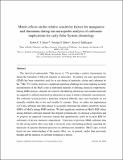Files in this item
Matrix effects on the relative sensitivity factors for manganese and chromium during ion microprobe analysis of carbonate : implications for early Solar System chronology
Item metadata
| dc.contributor.author | Steele, Robert C. J. | |
| dc.contributor.author | Heber, Veronika S. | |
| dc.contributor.author | McKeegan, Kevin D. | |
| dc.date.accessioned | 2018-09-07T13:30:05Z | |
| dc.date.available | 2018-09-07T13:30:05Z | |
| dc.date.issued | 2017-03-15 | |
| dc.identifier | 255735828 | |
| dc.identifier | 6b66f61f-e29a-45d7-ac3a-8781e3e6a151 | |
| dc.identifier | 85008700576 | |
| dc.identifier.citation | Steele , R C J , Heber , V S & McKeegan , K D 2017 , ' Matrix effects on the relative sensitivity factors for manganese and chromium during ion microprobe analysis of carbonate : implications for early Solar System chronology ' , Geochimica et Cosmochimica Acta , vol. 201 , pp. 245-259 . https://doi.org/10.1016/j.gca.2016.10.046 | en |
| dc.identifier.issn | 0016-7037 | |
| dc.identifier.other | ORCID: /0000-0003-1406-6855/work/64034758 | |
| dc.identifier.uri | https://hdl.handle.net/10023/15989 | |
| dc.description | This work was funded by the NASA Laboratory Analysis of Returned Samples program; the UCLA ims-1270 ion microprobe laboratory is partially supported by a grant from the NSF Instrumentation and Facilities Program. | en |
| dc.description.abstract | The short-lived radionuclide 53Mn decays to 53Cr providing a relative chronometer for dating the formation of Mn-rich minerals in meteorites. Secondary ion mass spectrometry (SIMS) has been extensively used for in situ dating of meteoritic olivine and carbonate by the 53Mn"–" 53Cr system, however a significant analytical challenge has been realising accurate measurements of the Mn/Cr ratio in individual minerals of differing chemical compositions. During SIMS analysis, elements are ionised with differing efficiencies and standard materials are required to calibrate measured ion intensities in terms of relative elemental concentrations. The carbonate system presents a particular analytical difficulty since such standards are not naturally available due to low and variable Cr contents. Here, we utilise ion implantation of Cr into carbonate and other phases to accurately determine the relative sensitivity factors of Mn/Cr during SIMS analysis. We find significant variations in Mn/Cr RSF values among different carbonate minerals that depend systematically on chemical composition and we propose an empirical correction scheme that quantitatively yields an accurate RSF for carbonates of diverse chemical compositions. Correction of SIMS carbonate data for this strong matrix effect may help to reconcile some outstanding problems regarding the timescales of aqueous alteration processes in carbonaceous chondrites. Mn–Cr ages, revised based our new understanding of the matrix effect, are, in general, earlier than previously thought and the duration of carbonate formation is shorter. | |
| dc.format.extent | 15 | |
| dc.format.extent | 280414 | |
| dc.language.iso | eng | |
| dc.relation.ispartof | Geochimica et Cosmochimica Acta | en |
| dc.subject | Early Solar System chronology | en |
| dc.subject | 53Mn | en |
| dc.subject | Cr isotopes | en |
| dc.subject | Secondary ion mass spectrometry | en |
| dc.subject | Relative sensitivity factor | en |
| dc.subject | Matrix effect | en |
| dc.subject | QB Astronomy | en |
| dc.subject | QD Chemistry | en |
| dc.subject | NDAS | en |
| dc.subject | BDC | en |
| dc.subject | R2C | en |
| dc.subject.lcc | QB | en |
| dc.subject.lcc | QD | en |
| dc.title | Matrix effects on the relative sensitivity factors for manganese and chromium during ion microprobe analysis of carbonate : implications for early Solar System chronology | en |
| dc.type | Journal article | en |
| dc.contributor.institution | University of St Andrews. School of Earth & Environmental Sciences | en |
| dc.identifier.doi | 10.1016/j.gca.2016.10.046 | |
| dc.description.status | Peer reviewed | en |
| dc.date.embargoedUntil | 2017-01-05 |
This item appears in the following Collection(s)
Items in the St Andrews Research Repository are protected by copyright, with all rights reserved, unless otherwise indicated.

